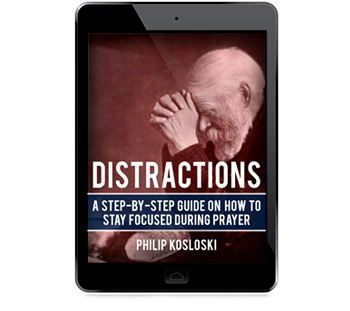Do you find it difficult to pray? So do I! I will be honest and say that prayer has never been easy for me and I still have days when I fail miserably. What prevents me from giving-up is knowing that prayer is not about me, but about God. It is about responding to His invitation of love and doing all that we can to battle any obstacles that come between us.
[featured-image single_newwindow=”false”]
Prayer is a “battle” and the battlefield is in our hearts. Will we give-up and run away or fight until the last breath leaves our body?
Just like any relationship, prayer does not “happen” overnight. Relationships develop over time and take a lot of effort to maintain. I did not meet my wife and then propose to her on the same day. I needed to develop our friendship first. Even after the wedding I could not hang up my hat and suddenly stop talking to my wife and never go out on another date. If I did our marriage would cease to exist.
It is the same with prayer.
We can not expect prayer to be perfect and never experience any difficulties. Even the saints struggled with prayer throughout their entire lives. Prayer requires great effort and is meant to grow over time.
The Catechism uses even stronger words and instructs us to engage in a “battle” in the midst of our difficulties,
“[O]ur battle has to confront what we experience as failure in prayer: discouragement during periods of dryness; sadness that, because we have “great possessions,” we have not given all to the Lord; disappointment over not being heard according to our own will….The conclusion is always the same: what good does it do to pray? To overcome these obstacles, we must battle to gain humility, trust, and perseverance” (CCC 2728, emphasis added).
Often this battle occurs against our own human nature, as the Catechism explains,
“In positive terms, the battle against the possessive and dominating self requires vigilance, sobriety of heart.” (CCC 2730).
The most common enemy during prayer is our own sinful tendencies and our own lack of virtue.
Another way to explain the complexity of prayer is by comparing it to physical exercise. Lifting weights and running long distances take time and effort to master. I can not simply go outside and sprint a full mile and expect to be a world-class runner. I must start slow and then gradually increase my speed over several months and years before I can master it.
It is the same with prayer.
As Jim Beckman explains,
“Neither does the interior life come naturally. Why is it that so many people can push through seemingly endless obstacles to work out, but when one hurdle presents itself to prayer or spiritual disciplines, most seem to falter? I believe that if we are going to succeed in the spiritual journey, we need to approach our spirituality a bit more like our workout schedule” (God, Help Me: How to Grow in Prayer, 112).
We should not stop praying when an obstacle or distraction comes our way. Prayer is not going to be easy and we shouldn’t expect to be perfect or receive divine revelations from an archangel. Saint Teresa of Avila explained the different levels of prayer in the terms of an “Interior Castle.” We do not immediately start out in the “Seventh Mansion,” but work our way closer to God from the outside, beginning in the “First.” This is very important to remember as it will put our prayer life in perspective.
Above all things, we should struggle and keep struggling. The worst thing that we can do is give-up. When we do that the Enemy of our soul is victorious.
Let us follow the banner of Christ and fight against the many obstacles of this world!
 Want some extra help? Here is an eBook to get you started!
Want some extra help? Here is an eBook to get you started!
Over the course of a few weeks, I have released several articles on staying focused during prayer and reducing unnecessary distractions. I received a very positive response from the articles, and many of you told me that it was very helpful and inspiring. After concluding the series, I decided to put the series together in an easy to read and beautifully formatted eBook that anyone could print off and go through during prayer at home or in front of the Blessed Sacrament.
I spent a good amount of time formatting, expanding and editing it to make a cohesive whole. I have added a few things, including reflection questions at the end of each chapter, and a list of resources that will help you get started.
The eBook has been formatted into a PDF version that you can read and print off using any PDF reader. It is 36 pages long.
If you are interested in reading this eBook on a Kindle device, please follow these instructions after downloading it.

